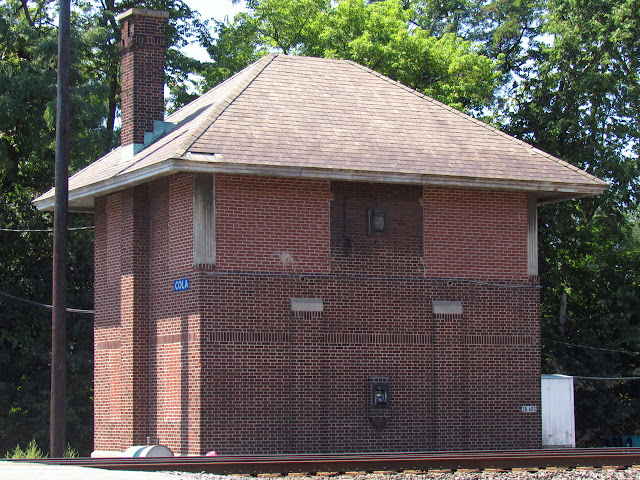Opened in 1938, COLA tower, in Columbia, PA was closed around 1986 and then served as a glorified relay hut until 2012 when the interlocking it controlled was re-signaled. In the decade that followed, the tower, sealed up against the elements and scrap enthusiasts, has been left largely untouched. Possibly still used as an employee clubhouse or storage facility, the stout construction and generally benign location have managed to defend the structure from demolition. I recently came into possession of some interior photos, taken a some years ago, that shine a light onto the tower's life and post-life.
Built at the same time, with the same design and for the same electrification project as the previously covered THORN tower, COLA used CTC remote control technology (although not much actual CTC territory) to streamline operations at what would be the hub of the low grade freight network between the Main Line junctions at Parkesburg and Perryville, and the massive Enola Yard near Harrisburg. COLA interlocking and its extended CTC territory were all extensively covered in my Port Road Trips series and so I will try to avoid covering the same ground again, however the key point worth remembering is that COLA's status as an all-relay based interlocking plant meant that when Conrail's NEC operations were severely curtailed in the mid to late 1980's and the east-west portion of the low grade network was abandoned, Conrail was able to close the tower as a Block and Interlocking Station, brick up the windows, install an interface and control the whole plant from a computer terminal in Mt. Holly, NJ just as easily as it had from the operator's console on the second floor.
25 years later Norfolk Southern finally got around to replacing the still 1938 vintage signaling at COLA as part of an area re-signaling scheme that covered much of COLA's former CTC territory and it turns out that they pretty much locked the door and walked away. On the operator's level, the CTC console has vanished (most likely into an employee's basement), but it's outline is still present along with the operator's chairs and a pretty snazzy Kelvinator.
Lockers for the operators are still standing against the wall and one can see the crudeness of the 1980's brick job compared with the large tile on the proper walls. At least Conrail decided to opt for brick as opposed to cinder blocks or plywood. Also note the institutional grade water fountain, which were the style in the days before bottled water.
On the wall behind the operator's position are a variety of railroad preservation related news clippings, pasted up an "enthusiast" operator along with various notes of a more work related nature. Banana stickers abound along with clues that smoking as still permitted inside.
The washroom appears to be of PRR vintage and along with the radiant heat system speak to how the ostensibly value focused PRR wasn't afraid to pay for quality. COLA, with its CTC system and indoor heat and plumbing was state of the art in 1937, on par with today's amenity filled Silicon Valley HQ's.
Adjacent to the washroom, aftermarket racks were installed to hold what may have been defect detector equipment.
The other front corner of the operator's floor features a rack for more modern technology, either the remote control equipment or something to do with a radio base.
The back corner has the tower's only non-bricked window along with the old telephone plug board. Around the corner, the stairs were enclosed with drywall, possibly to make the control room easier to heat.
The first floor holds the relay equipment that controlled about 25 unit levers worth of switches and signals. Here on the left we can see the terminal board that defines the interface between internal wiring and cables out to the field. On the right is the wire cage that partitions off the relay area, which tended to be off limits to the signal employees.
The relay room consisted of four rows of relays in three isles, with two additional cable isles stod between the relay isles.
The first surprise was that all of the relays were of the shelf type, whereas the 1948 vintage CTC addon to OVERBROOK tower used plug style relays. I had always assumed that CTC technology had gone hand in hand with the advancement to plug relays. The second surprise was the large number of relays just abandoned in place on the shelves. Many had the wires cut and some of the shelves had been stripped bare, but I guess it's good to know that railroads are sitting on a strategic relay reserve.
In the base corner was the telephone interface, more bricked windows and a modern ventilation fan.
One more flight of stairs and we reach the basement which contains a maintainer work space and cable storage. The strength of the foundation is palpable with the poured concrete showing no evidence of deterioration. Also note the size and quantity of vintage string and tar insulated cables running from the relay level, into the basement and then out through the foundation to the field equipment. Reminds me a lot of old Bell System infrastructure.
Well that's the extent of the photos I received. Hopefully COLA tower will fly under the demolition radar in the decades to come.
























No comments:
Post a Comment